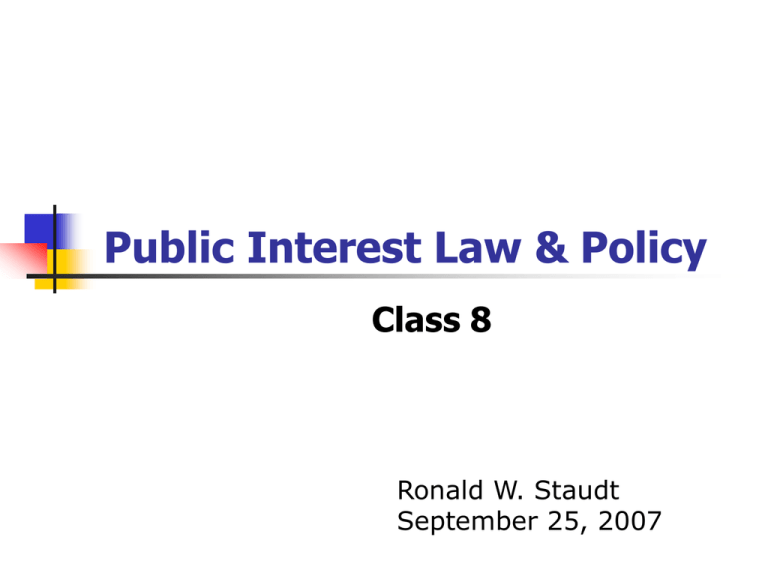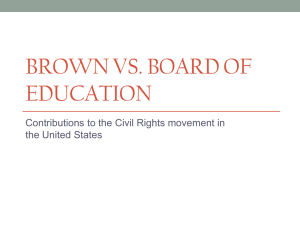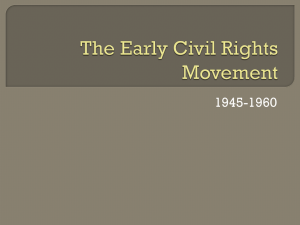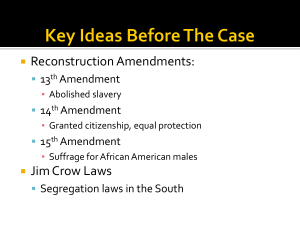Class Outline
advertisement

Public Interest Law & Policy Class 8 Ronald W. Staudt September 25, 2007 Brown v. Board of Education Read: Brown v. Board of Education of Supp. 797 (D.C. Kan 1951). Brown v. Board of Education of U. S. 483 (1954) Brown v. Board of Education of U. S. 294 (1955) Bolling v. Sharpe 347 U. S. 497 Review: Topeka, 98 F. Topeka et al. 347 Topeka et al. 349 (1954) Case Study 1- Brown v. Board of Education by Frank Bieszczat, Farterria Bundy and Stephanie Crowell Brown v. Board of Education of Topeka, 98 F. Supp. 797 (D.C. Kan 1951). [Plaintiffs] contend that the opportunities provided for the infant plaintiffs in the separate all Negro schools are inferior to those provided white children in the all white schools; that the respects in which these opportunities are inferior include the physical facilities, curricula, teaching resources, student personnel services as well as all other services . … they contend that apart from all other factors segregation in itself constitutes an inferiority in educational opportunities offered to Negroes and that all of this is in violation of due process guaranteed them by the Fourteenth Amendment to the United States Constitution. Brown v. Board of Education of Topeka, 98 F. Supp. 797 (D.C. Kan 1951). We have found as a fact that the physical facilities, the curricula, courses of study, qualification of and quality of teachers, as well as other educational facilities in the two sets of schools are comparable. … We conclude that in the maintenance and operation of the schools there is no willful, intentional or substantial discrimination in the matters referred to above between the colored and white schools. In … Plessy v. Ferguson, 163 U.S. 537, the Supreme Court said: 'The object of the amendment was undoubtedly to enforce the absolute equality of the two races before the law, but, in the nature of things, it could not have been intended to abolish distinctions based upon color, or to enforce social, as distinguished from political equality, or a commingling of the two races upon terms unsatisfactory to either. Laws permitting, and even requiring, their separation, in places where they are liable to be brought into contract, do not necessarily imply the inferiority of either race to the other, and have been generally, if not universally, recognized as within the competency of the state legislatures in the exercise of their police power. The most common instance of this is connected with the establishment of separate schools for white and colored children, which has been held to be a valid exercise of the legislative power even by courts of states where the political rights of the colored race have been longest and most earnestly enforced.' McLaurin v. Oklahoma, 339 U.S. 637 'It may be argued that appellant will be in no better position when these restrictions are removed, for he may still be set apart by his fellow students. This we think irrelevant. There is a vast difference- a Constitutional difference- between restrictions imposed by the state which prohibit the intellectual commingling of students, and the refusal of individuals to commingle where the state presents no such bar. * * * having been admitted to a statesupported graduate school, (he), must receive the same treatment at the hands of the state as students of other races.' (339 U.S. 637, 70 S.Ct. 853.) Sweatt v. Painter, 339 U.S. 629 In its opinion the Supreme Court stressed the educational benefits from commingling with white students. The court concluded by stating: 'we cannot conclude that the education offered petitioner (in a separate school) is substantially equal to that which he would receive if admitted to the University of Texas Law School.' Reluctantly, If segregation within a school as in the McLaurin case is a denial of due process, it is difficult to see why segregation in separate schools would not result in the same denial. Or if the denial of the right to commingle with the majority group in higher institutions of learning as in the Sweatt case and gain the educational advantages resulting therefrom, is lack of due process, it is difficult to see why such denial would not result in the same lack of due process if practiced in the lower grades. DC rules against the plaintiffs …in both of these cases the Supreme Court made it clear that it was confining itself to answering the one specific question, namely: 'To what extent does the Equal Protection Clause * * * limit the power of a state to distinguish between students of different races in professional and graduate education in a state university?', and that the Supreme Court refused to review the Plessy case because that question was not essential to a decision of the controversy in the case. We are accordingly of the view that the Plessy and Lum cases, supra, have not been overruled and that they still presently are authority for the maintenance of a segregated school system in the lower grades. Brown I, 347 U. S. 483 (1954) The plaintiffs contend that segregated public schools are not "equal“ and cannot be made "equal," and that hence they are deprived of the equal protection of the laws. 14th Amendment, Section 1 All persons born or naturalized in the United States, and subject to the jurisdiction thereof, are citizens of the United States and of the State wherein they reside. No State shall make or enforce any law which shall abridge the privileges or immunities of citizens of the United States; nor shall any State deprive any person of life, liberty, or property, without due process of law; nor deny to any person within its jurisdiction the equal protection of the laws. Arguments Text itself makes school segregation unconstitutional Framers intended that school segregation prohibited by the 14th Amend. Reargument – inconclusive/ education different in 1878. Precedent – Plessy now directly at issue Schools are equal in record Subjugation rationale Moral argument Brown I, holding We conclude that in the field of public education the doctrine of "separate but equal" has no place. Separate educational facilities are inherently unequal. Therefore, we hold that the plaintiffs and others similarly situated for whom the actions have been brought are, by reason of the segregation complained of, deprived of the equal protection of the laws guaranteed by the Fourteenth Amendment. Bolling v. Sharpe 347 U. S. 497 (1954) The Fifth Amendment, which is applicable in the District of Columbia, does not contain an equal protection clause as does the Fourteenth Amendment which applies only to the states. But the concepts of equal protection and due process, both stemming from our American ideal of fairness, are not mutually exclusive. … as this Court has recognized, discrimination may be so unjustifiable as to be violative of due process. Amendment V No person…shall be deprived of life, liberty, or property, without due process of law… Bolling v. Sharpe Liberty under law extends to the full range of conduct which the individual is free to pursue, and it cannot be restricted except for a proper governmental objective. Segregation in public education is not reasonably related to any proper governmental objective, and thus it imposes on Negro children of the District of Columbia a burden that constitutes an arbitrary deprivation of their liberty in violation of the Due Process Clause. Brown II How should Brown I be enforced: “Because of their proximity to local conditions and the possible need for further hearings, the courts which originally heard these cases can best perform this judicial appraisal. Accordingly, we believe it appropriate to remand the cases to those courts.” Brown II the courts may consider problems related to administration, arising from the physical condition of the school plant, the school transportation system, personnel, revision of school districts and attendance areas into compact units to achieve a system of determining admission to the public schools on a nonracial basis, and revision of local laws and regulations which may be necessary in solving the foregoing problems. They will also consider the adequacy of any plans the defendants may propose to meet these problems and to effectuate a transition to a racially nondiscriminatory school system. During this period of transition, the courts will retain jurisdiction of these cases. Brown II “The judgments below, except that in the Delaware case, are accordingly reversed and the cases are remanded to the District Courts to take such proceedings and enter such orders and decrees consistent with this opinion as are necessary and proper to admit to public schools on a racially nondiscriminatory basis with all deliberate speed the parties to these cases.”






